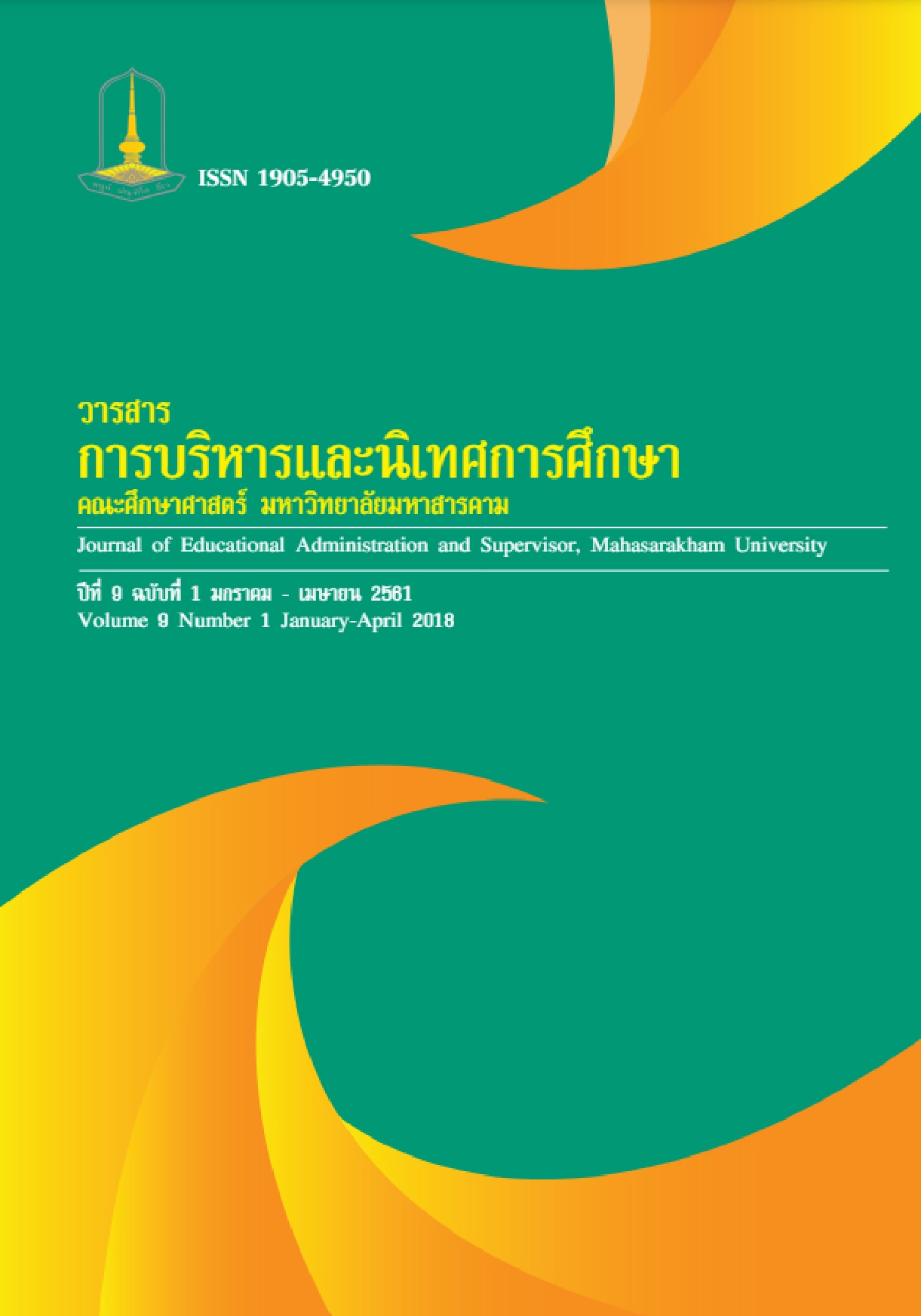Guidelines for developing an academic administration in large-sized schools under the supervision of chaiyaphum primary educational service area office 3
Main Article Content
Abstract
The research aimed at studying the current state, desirable state and guidelines for developing an academic administration in large-sized schools under Chaiyaphum Primary Educational Service Area Office 3. The samples of the study, determined by the use of Krejcie and Morgan’s table, comprised 268 school administrators and teachers in large-sized schools under Chaiyaphum Primary Educational Service Area Office 3. The instruments used to collect data were composed of 1) sets of the five-point Likert scale questionnaires on the current and desirable states of academic administration in large-sized schools under Chaiyaphum Primary Educational Service Area Office 3 and 2) interview forms with open-ended questions on the guidelines for developing an academic administration in large-sized schools under Chaiyaphum Primary Educational Service Area Office 3. In tryout process, the reliability of the survey was conducted with 30 individuals excluding the sample population. The discrimination value between 0.67 - 0.85 and the whole questionnaire’s reliability value of 0.93 were founded. The statistics used for analyzing data on the current and desirable states were mean and standard deviation. Regarding the guidelines for developing an academic administration in large-sized schools under Chaiyaphum Primary Educational Service Area Office 3, the survey was based on schools with best practice. The results of the research were as follows: 1) The teachers viewed that an overall current state of academic administration in large-sized schools under Chaiyaphum Primary Educational Service Area Office 3 was at high level. When considering each aspect, it was found that all aspects were at high level. 2) The teachers viewed that an overall desir-able state of academic administration in large-sized schools under Chaiyaphum Primary Educational Service Area Office 3 was at highest level. When considering each aspect, there were five aspects which gained highest level including school curriculum development, learning process improvement, learning evaluation and credit transfer process, research for educational development and academic supervision respectively. Possible guidelines for developing an academic administration were proposed as follows: 1) The conference between school administrators and board members should be held to promote the development of school curriculum according to vision, missions, goals and desired characteristics of the academic performance. 2) The teachers should provide student-centered learning activities to improve learning process. 3) In learning evaluation and assessment as well as credit transfer process, the conference between school administrators and board members should be held to specify the evaluation and assessment rules. 4) In terms of the research for educational development, teachers should be encouraged to create and use multiple innovations. 5) For the development of instructional media innovation and technology, appropriate media and technology should be provided to support learning management. 6) The school learning center and external learning resources in local community should be explored to support academic and learning resources improvement. 7) As of the learning supervision aspect, up-to-date information and data analysis is needed for an instructional process.
Downloads
Article Details
References
กรมวิชาการ. (2545). หลักสูตรการศึกษาขั้นพื้นฐาน พุทธศักราช 2545. กรุงเทพฯ: องค์การรับส่งสินค้าและพัสดุภัณฑ์ (ร.ส.พ.).
กระทรวงศึกษาธิการ. (2546). คู่มือการบริหารสถานศึกษาขั้นพื้นฐานที่เป็นนิติบุคคล. กรุงเทพฯ: คุรุสภาลาดพร้าว.
กระทรวงศึกษาธิการ. (2551). หลักสูตรการศึกษาขั้นพื้นฐานพุทธศักราช 2551. กรุงเทพฯ: โรงพิมพ์คุรุสภาลาดพร้าว.
ชุมศักดิ์ อินทร์รักษ์. (2545). รายงานวิจัยรูปแบบการบริหารงานวิชาการในเขตพื้นทีการศึกษาในห้าจังหวัดชายแดนใต้. ม.ป.ท.
บุญชม ศรีสะอาด. (2545). การวิจัยเบื้องต้น. กรุงเทพฯ: สุวีริยาสาน์ส. รุจิร์ ภู่สาระ และจันทรานี สงวนนาม. (2545). การบริหารหลักสูตรในสถานศึกษา. กรุงเทพฯ: บุ๊คพอยท์.
สิทธิพร นิยมศรีสมศักดิ์. (2546). หลักการบริหารการศึกษา = Education administration. ชลบุรี: คณะศึกษาศาสตร์ มหาวิทยาลัยบูรพา.
สันติ บุญภิรมย์. (2552). การบริหารงานวิชาการ. กรุงเทพฯ: บุ๊คส์พอยท์.
สำนักงานเขตพื้นที่การศึกษาประถมศึกษาชัยภูมิ เขต 3. (2558). แผนพัฒนาการศึกษาสี่ปี. ชัยภูมิ: สำนักงานเขตพื้นที่การศึกษาประถมศึกษาชัยภูมิ เขต 3.
สำนักงานคณะกรรมการการศึกษาแห่งชาติ. (2543). การปฏิรูปการเรียนรู้ ผู้เรียนสำคัญที่สุด. กรุงเทพฯ: คุรุสภาลาดพร้าว.
สำนักงานคณะกรรมการการศึกษาขั้นพื้นฐาน. (2550). แนวทางการกระจายอำนาจการบริหารและการบริหารจัดการการศึกษาให้คณะกรรมการสำนักงานเขตพื้นที่การศึกษาและสถานศึกษาตามกฎกระทรวง กำหนดหลักเกณฑ์ และวิธีการกระจายอำนาจการบริหารและการจัดการศึกษา พ.ศ. 2550. กรุงเทพฯ: ชุมนุมสหกรณ์การเกษตรแห่งประเทศไทย.
อำรุง จันทวานิช. (2547). แนวทางการบริหารและการพัฒนาสถานศึกษาสู่โรงเรียนคุณภาพ. กรุงเทพฯ: โครงการผู้บริหารสถานศึกษาต้นแบบ สำนักงานนโยบายและแผนการศึกษา สำนักงานเลขาธิการสภาการศึกษา.
Glickman, Carl D. (1985). Supervision of Instruction: A Development Approach. Massachusetls: Allyn and Bacon Inc, 1985.


